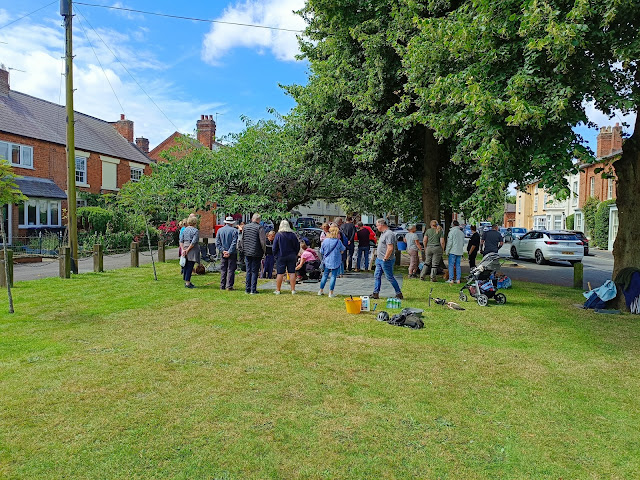Here are some of the email and Facebook comments we've received following our Festival of Archaeology digs. It was hard work but we very much look forward to doing it all again next year!
25 Jul 2024
More Discoveries at Oak House
Our three-day test pit dig at Oak House which ended today was a great success. Thirty three years ago a number of exploratory trenches were dug in the back garden of this grand old house and in one, the corner of a wall foundation was found. No further investigation was carried out at the time so our objective for this dig was to locate the structure and look for any dating evidence.
We know that the building was in existence in the 1840s since it's illustrated on the parish tithe map but it had been demolished by the late 1800s when the house was converted to a museum. After serving as 'pleasure gardens', the back lawn became a bowling green in the 20th century. The garden is now undergoing partial 're-wilding' with an emphasis on a sustainable wildlife habitat rather than formal mown lawns which have little environmental benefit.
While we didn't find anything in a sealed archaeological context to provide a date, we did locate our target and discovered a little more information.
The foundations consist of large sandstone blocks on top of which lies a 10cm (4 inch) thick 'pad' of sandstone fragments, tile and mortar, which is wider than the blocks. Why this overhang exists isn't clear but we plan to carry out a more extensive excavation in the near future which may answer this question and provide a date.
A 3D photogrammetry model can be found here.
14 Jul 2024
Another Successful Community Dig
Our Festival of Archaeology dig at Albrighton today attracted many visitors with lots of enthusiasm for learning more about their local history and many interesting questions.
The fine weather meant we had around two dozen people around the test pit at most times of day, with adults and children taking part and making discoveries for themselves.
Find of the day was an early Georgian halfpenny and the most interesting feature was a man-made yellow sandstone surface although what purpose it served we cannot say for certain.
1 Jul 2024
Walls, walls and more walls!
After almost three months work at the former inn, our initial objective, to discover its outline and the position of its internal walls is nearing completion. As a result we're now moving from the exploratory to investigation phase, when the archaeology proper begins!
Our first target is the well defined ash-pit and what remains of its adjoining privy at the rear of the premises. Post 1870 widening of the gap between the pub and the farm buildings involved demolition of some old parts of the domestic side of the inn and construction of a new boundary wall which also extended the ash-pit. This explains the unusual shape of the ash-pit, shown in this photo:
What remains of the privy is at bottom right. Its walls and the east wall of the ash pit are all angled slightly west of north whereas the new wall at the top and the west wall are set at a different angle.
On-going excavation of the ash pit fill (below the demolition rubble, which has been removed) is starting to yield some interesting results.
A photogrammetry model of work in progress can be viewed here. It shows how the extended ash-pit has a sloping floor (or deposit?) of sand and pebble. Whether we will find a 'proper' brick floor below remains to be seen.






